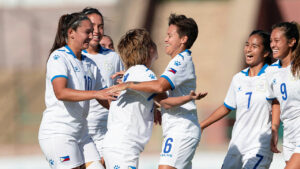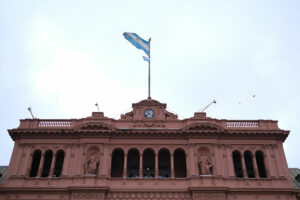Women’s sports making their move, one step at a time

The new year started with media refocusing its attention on the Philippine women’s national football team which in 2022 qualified for the FIFA Women’s World Cup in July-August 2023 which will be jointly hosted by Australia and New Zealand. The Filipinas, formerly called the Malditas, qualified for the first time to the World Cup when they made it to the semifinals of the AFC Asian Cup.
The Filipinas’ 2022 campaign was certainly a fruitful one, with the squad winning the bronze medal at the 31st Southeast Asian Games (SEAG) in Vietnam. This was followed by the country’s the first ever regional trophy when the team won the AFF Women’s Championship in the Philippines.
The maiden appearance of the Filipinas at the 2023 FIFA Women’s World Cup is a high mark in the checkered history of Philippine football.
It might be bit instructive to go into a bit of Philippine history to better understand the rough and rocky road that Philippine football — and organized sports in general — traveled over the last 120 years.
Close to the start of the 20th century, in 1898, the United States declared war on Spain which by then was losing its grip on whatever was left of its colonies, including Cuba. The Spanish forces sank the American battleship Maine in Havana, Cuba, after which the Americans declared war on Spain on April 25, 1898. The United States brought the war against the fading Spanish empire to the Philippines. By the time the US had entered Manila Bay, the Filipino forces were all but ready to oust the Spaniards.
Fearing reprisals from the indios or the natives for the centuries-long atrocities they committed, the Spaniards chose to strike a deal with the Americans to avoid the ignominy of surrendering to the under-equipped, bolo-wielding brown-skinned “savages.” Both American and Spanish forces waged what was known as an “acoustic war” on Manila Bay, with naval forces of both countries exchanging fire that harmed no one. It was part of a plan to deprive the natives of the chance of forming their own nation. It was a conspiracy that was formalized through the Treaty of Paris and capped by the US buying the Philippines from Spain for $20 million. The Filipinos had been passed on from one master to another.
Hardly had the ink dried on the Treaty, when the Americans sent the USS Army Transport Thomas that had as its passengers an assortment of businessmen, educators, missionaries and others whose presence in the Philippines would firmly establish America’s influence in, and control over, the 7,000 or so islands. The new arrivals were known as the “Thomasites.”
The missionaries and members of what would be the American Young Men’s Christian Association (YMCA), lost no time in their proselytization and evangelization even as the bloody Philippine-American war raged. The missionaries traveled to north and south of the archipelago, with the educators traveling to Dumaguete, Negros Oriental in the south to help establish the Siliman University. Up north, the Americans covered the mineral-rich Baguio-Benguet area.
Along with Coca-Cola and other consumer products, and American culture and system of governance, they also brought in their system of education which included Physical Education and organized sports.
While the Americans brought in track and field (athletics), baseball, swimming, softball, and boxing, a European sport, football, continued to be popular — no doubt due to the Spanish influence established over 370 years. The Philippines won the gold medal in football in the first Far Eastern Games in 1913, the forerunner of the Asian Games. The countries that participated in the Games were: the Philippines, China, Japan, Thailand, the British East Indies (Malaysia), and the British Crown Colony of Hong Kong. That was to be the first and the last time that the Philippines would win a medal in men’s football at the Asian continental level.
During the heyday of Philippine football at that time, the star of Paulino Alcantara Riestra — the son of a Spanish military officer married to an Ilongga from Concepcion, Iloilo — shone bright. Alcantara was a member of the Philippine football team to the Far Eastern Games in 1917 held in Tokyo. Alcantara led the Philippines to a 15-2 victory over host Japan. He played for the Barcelona club and was its youngest player.
What happened to Philippine football in the 1920s and ’30s? The Americans introduced sports such as basketball, track and field, swimming, and baseball. School and YMCA facilities had basketball courts and swimming pools and diving facilities. Baseball occasionally gained some media prominence with the visit of baseball greats like Babe Ruth.
Football sometimes gained a bit of attention, but mainly from the upper levels of society of Spanish parentage whose contacts with football clubs in nearby Hong Kong enlivened the environment.
Other than that, it was all basketball in the ensuing decades — until local businessmen and the national sports association of football and some Local Government Units and schools came together to build up a more competitive men’s team comprised of both Philippine-based and Filipino-foreign players. It was during the period from 2008-2016 that the men’s team improved its international ranking.
The attention given to and the superb performance of the Filipinas reflects the worldwide trend of recognizing the impact of women’s sports. With gender equity and the promotion and defense of women’s rights being taken seriously by both men and women and governments and entire societies, women’s sports can, on their own, draw crowds, sponsors, and networks. The US women’s team demanded from the US football governing body the same pay as the men’s team. The equal pay demand was met.
There are, of course, other factors that attract fans to women’s sports. The surge in popularity of women’s collegiate volleyball in the Philippines in the early 2000s was due, no doubt, to the rivalry between De La Salle and Ateneo, such rivalry extending (amusingly) into almost all aspects of human activity.
At the international level, a winning team will draw 17,000-20,000 fans to a football stadium, crowds that only basketball and women’s volleyball competitions (and rock concerts) can attract.
Like the Azkals, the Filipinas have a strong Filipino-Overseas line-up. These overseas players had the benefit of training in countries like the US, the UK, Australia, Sweden, Taiwan, and Japan, and competing in top level leagues in these football hotspots.
The Filipino diaspora has resulted in millions of Filipino emigrants’ offspring, some of whom have become athletes living and playing in other countries and benefiting from the training and competitive environment in their home and neighboring nations. It is to be noted that more than one half of the national women’s football squad is of mixed Filipino and foreign parentage.
Olivia Davies-McDaniel is a 23-year-old American-born Filipino goalkeeper. McDaniel’s mother is Lindy, who has roots in Pampanga and Davao City. McDaniel was a member of the team that played in the quarterfinals match against Chinese-Taipei. The match went on to a penalty shoot-out. McDaniel stopped two of three penalty attempts by Chinese-Taipei. She converted one penalty kick herself.
Inna Palacios, 28, is the goalkeeper of the national squad. She is one of four Philippine-based players who have joined hands with the Filipino-Overseas players to help the Philippines achieve this trailblazing feat. The three other ladies are members of the De La Salle football team, to which Palacios also belonged before she finished college. Palacios, a graduate of Colegio San Agustin, was heavily scouted by other schools in the UAAP.
Ranked 53rd, the Philippine team is the lowest qualifier among 32 countries seeing action in July this year. But that should not really matter. The important thing is the country is in the game. One step at a time. Being there is already an achievement.
Philip Ella Juico’s areas of interest include the protection and promotion of democracy, free markets, sustainable development, social responsibility and sports as a tool for social development. He obtained his doctorate in business at De La Salle University. Dr. Juico served as secretary of Agrarian Reform during the Corazon C. Aquino administration.




